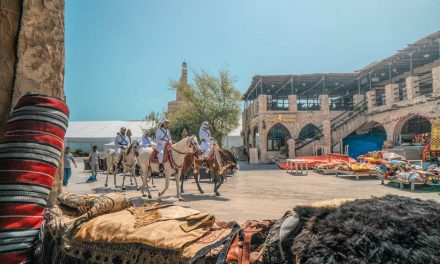Table of Contents
From Camel Racing to Robotics: Leading the Arab World’s Evolution.
Introduction
“Camel Racing to Robotics: The Evolution of Leadership in the Arab World” explores the transformative journey of leadership in the Arab world, tracing its evolution from traditional practices to the modern era of robotics. This captivating study delves into the rich history and cultural significance of camel racing, a traditional sport deeply rooted in Arab heritage, and examines how it has paved the way for the emergence of innovative leadership approaches in the realm of robotics. By analyzing this evolution, we gain valuable insights into the changing dynamics of leadership in the Arab world and the remarkable adaptability of its leaders in embracing technological advancements.
The Historical Significance of Camel Racing in the Arab World

Camel racing has a long and storied history in the Arab world, dating back centuries. It has not only been a popular sport but also a significant cultural tradition that has shaped the region’s leadership values and practices. Understanding the historical significance of camel racing is crucial in comprehending the evolution of leadership in the Arab world.
Camel racing originated in the Arabian Peninsula, where it was initially a means of transportation and a vital part of Bedouin culture. The Bedouins, nomadic tribes that roamed the desert, relied heavily on camels for survival. These animals were not only used for transportation but also for milk, meat, and wool. As a result, camel racing became an essential skill for the Bedouins, as it allowed them to navigate vast distances quickly and efficiently.
Over time, camel racing evolved from a practical skill to a competitive sport. It became a way for tribes to showcase their wealth, power, and prestige. The races were not only about speed but also about the quality and breeding of the camels. The tribes would invest significant resources in breeding and training the fastest and strongest camels, creating a sense of pride and honor within their communities.
The historical significance of camel racing in the Arab world lies in its connection to leadership. In Bedouin society, the ability to race camels was seen as a demonstration of leadership qualities such as courage, skill, and strategic thinking. The most successful camel racers were often revered as leaders within their tribes, and their expertise in racing translated into their ability to lead and make wise decisions.
Furthermore, camel racing served as a platform for social and political interactions. Tribal leaders would gather at races to discuss important matters, negotiate alliances, and resolve conflicts. The races provided a space for leaders to showcase their influence and build relationships with other tribes, fostering a sense of unity and cooperation within the Arab world.
As the Arab world transitioned from a nomadic society to a more modern and urbanized one, camel racing underwent significant changes. The introduction of technology, such as robotic jockeys, revolutionized the sport. Robotic jockeys replaced child jockeys, who were often subjected to dangerous conditions and exploitation. This shift not only improved the welfare of children but also allowed for more precise control and enhanced performance in races.
The evolution of camel racing reflects the changing dynamics of leadership in the Arab world. As the region modernized, leadership values shifted from traditional Bedouin qualities to a more technologically driven approach. The ability to adapt to new technologies and embrace innovation became essential for leaders in the Arab world.
In conclusion, the historical significance of camel racing in the Arab world cannot be understated. It has shaped leadership values and practices, serving as a symbol of courage, skill, and strategic thinking. The transition from a practical skill to a competitive sport reflects the changing dynamics of leadership in the region. As the Arab world continues to evolve, it is crucial to recognize and understand the historical roots of leadership in order to navigate the challenges and opportunities of the future.
Traditional Leadership Styles in the Arab World
Camel Racing to Robotics: The Evolution of Leadership in the Arab World
Traditional Leadership Styles in the Arab World
Leadership is a concept that has evolved over time, adapting to the changing needs and circumstances of societies. In the Arab world, leadership has traditionally been characterized by certain styles that have been shaped by cultural, historical, and social factors. These traditional leadership styles have played a significant role in shaping the region’s history and development.
One of the most prominent traditional leadership styles in the Arab world is the tribal leadership model. In this model, leadership is based on kinship ties and loyalty to the tribe. The tribal leader, often referred to as the sheikh, is responsible for making decisions that benefit the entire tribe. This style of leadership emphasizes the importance of unity, cooperation, and collective decision-making.
Another traditional leadership style in the Arab world is the religious leadership model. Islam, the dominant religion in the region, has had a profound influence on leadership practices. Religious leaders, such as imams and scholars, have traditionally played a significant role in guiding and influencing their communities. They are seen as moral authorities and are responsible for interpreting religious texts and providing guidance on matters of faith and morality.
In addition to tribal and religious leadership, the Arab world has also seen the emergence of political leadership. With the establishment of modern nation-states in the region, political leaders have taken on the responsibility of governing and representing their countries. These leaders are often elected or appointed and are expected to make decisions that benefit the nation as a whole. Political leadership in the Arab world has been shaped by various ideologies, including nationalism, socialism, and more recently, democracy.
While traditional leadership styles have played a crucial role in the Arab world, they have also faced criticism and challenges in recent years. As societies become more globalized and interconnected, there is a growing recognition of the need for leadership styles that are adaptable, inclusive, and responsive to the changing needs of the population.
One area where this evolution of leadership is particularly evident is in the field of technology and innovation. The Arab world has made significant strides in recent years in areas such as robotics, artificial intelligence, and renewable energy. These advancements have required leaders who are not only knowledgeable in these fields but also possess the skills to navigate the complexities of the global market.
In response to these changing dynamics, there has been a shift towards a more entrepreneurial and innovative leadership style in the Arab world. This style emphasizes creativity, risk-taking, and the ability to adapt to rapidly changing circumstances. Leaders in this model are encouraged to think outside the box, foster a culture of innovation, and empower their teams to take ownership of their work.
The evolution of leadership in the Arab world is a reflection of the region’s aspirations for progress and development. As societies continue to evolve, so too must their leaders. The traditional leadership styles that have served the Arab world well in the past are being reimagined and adapted to meet the challenges of the future. Whether it is in the realm of technology, politics, or social change, the Arab world is witnessing a new generation of leaders who are shaping the region’s future.
The Role of Technology in Shaping Leadership in the Arab World
The Arab world has a rich history and a diverse culture that has been shaped by various factors over the centuries. One of the most significant factors that have influenced the region is technology. From the early days of camel racing to the modern era of robotics, technology has played a crucial role in shaping leadership in the Arab world.
In the past, leadership in the Arab world was often centered around traditional practices and customs. Camel racing, for example, was a popular sport that showcased the skills and leadership abilities of individuals. The leaders of camel racing teams were responsible for training and managing the camels, as well as leading their teams to victory. This required a unique set of skills, including the ability to communicate effectively with the camels and to make quick decisions during races.
However, as technology advanced, so did the role of leadership in the Arab world. The introduction of modern transportation, such as cars and airplanes, brought about a shift in the way leaders operated. Instead of relying solely on traditional methods, leaders began to embrace technology to enhance their leadership abilities. This included using cars to travel quickly between different regions and using airplanes to expand their influence beyond their immediate surroundings.
The rise of the internet and digital technology further revolutionized leadership in the Arab world. With the advent of social media platforms and online communication tools, leaders were able to connect with a wider audience and disseminate their ideas more effectively. This allowed for greater transparency and accountability in leadership, as leaders were now under constant scrutiny from the public.
Furthermore, technology has also played a significant role in empowering individuals and promoting a more inclusive form of leadership in the Arab world. The rise of robotics and artificial intelligence has opened up new possibilities for leadership development. For example, robotics competitions have become increasingly popular in the region, providing young people with the opportunity to develop their leadership skills through the design and programming of robots.
Additionally, technology has also facilitated the emergence of new forms of leadership in the Arab world. Online platforms and digital tools have allowed for the rise of grassroots movements and online activism, enabling individuals to mobilize and advocate for change. This has challenged traditional notions of leadership and has given rise to a more decentralized and participatory form of leadership.
In conclusion, technology has played a pivotal role in shaping leadership in the Arab world. From the early days of camel racing to the modern era of robotics, technology has transformed the way leaders operate and has opened up new possibilities for leadership development. The rise of digital technology has empowered individuals and promoted a more inclusive form of leadership, while also challenging traditional notions of leadership. As technology continues to advance, it will undoubtedly continue to shape leadership in the Arab world and beyond.
The Impact of Robotics on Leadership Practices in the Arab World
The Arab world has a rich history of leadership, with traditional practices deeply rooted in cultural and historical contexts. However, with the advent of technology and the rise of robotics, leadership practices in the Arab world have undergone a significant transformation. This article explores the impact of robotics on leadership practices in the Arab world, highlighting the key changes and challenges faced by leaders in this evolving landscape.
One of the most notable impacts of robotics on leadership in the Arab world is the shift towards a more collaborative and inclusive leadership style. Traditionally, leadership in the Arab world has been characterized by a hierarchical structure, with leaders making decisions and giving orders. However, with the introduction of robotics, leaders are now required to work alongside machines and artificial intelligence, necessitating a more collaborative approach.
This shift towards collaboration has been driven by the need to effectively integrate robotics into various industries and sectors. Leaders in the Arab world are now required to work closely with robotics experts and technicians to ensure the successful implementation and operation of robotic systems. This collaborative approach not only enhances the efficiency and productivity of organizations but also fosters a culture of innovation and creativity.
Furthermore, the introduction of robotics has also necessitated a greater emphasis on adaptability and flexibility in leadership practices. In the past, leaders in the Arab world were often revered for their steadfastness and unwavering commitment to tradition. However, with the rapid advancements in robotics, leaders are now required to adapt to new technologies and embrace change.
This adaptability is crucial in ensuring that organizations remain competitive in the global market. Leaders must be willing to learn and acquire new skills to effectively navigate the complexities of robotics. This includes understanding the technical aspects of robotics, as well as the ethical and social implications associated with their use.
However, the integration of robotics into leadership practices in the Arab world is not without its challenges. One of the key challenges faced by leaders is the fear of job displacement. With the increasing automation of tasks, there is a concern that robots will replace human workers, leading to unemployment and social unrest.
Leaders in the Arab world must address these concerns by implementing policies and strategies that ensure a smooth transition to a more automated workforce. This includes retraining and upskilling workers to take on new roles that complement robotic systems. Additionally, leaders must also focus on creating a supportive and inclusive work environment that values human skills and capabilities.
In conclusion, the impact of robotics on leadership practices in the Arab world has been significant. The shift towards a more collaborative and inclusive leadership style, as well as the emphasis on adaptability and flexibility, has transformed the way leaders operate in this evolving landscape. However, leaders must also address the challenges associated with the integration of robotics, particularly the fear of job displacement. By embracing change and implementing effective strategies, leaders in the Arab world can harness the potential of robotics to drive innovation and economic growth.
Q&A
1. What is the topic of “Camel Racing to Robotics: The Evolution of Leadership in the Arab World”?
The topic is the evolution of leadership in the Arab world, specifically focusing on the transition from traditional activities like camel racing to modern advancements in robotics.
2. What does the article discuss regarding leadership in the Arab world?
The article discusses how leadership in the Arab world has evolved over time, highlighting the shift from traditional practices to embracing technological advancements like robotics.
3. What are some examples of traditional activities mentioned in the article?
Camel racing is mentioned as one of the traditional activities in the Arab world that has been replaced by modern advancements in robotics.
4. What is the main focus of the article?
The main focus of the article is to explore the transformation of leadership in the Arab world, specifically examining the transition from traditional activities to embracing robotics and technological advancements.
Conclusion
In conclusion, “Camel Racing to Robotics: The Evolution of Leadership in the Arab World” highlights the transformation of leadership in the Arab world from traditional practices to embracing technological advancements. The shift from camel racing, a symbol of traditional leadership, to robotics signifies the region’s commitment to innovation and progress. This evolution reflects the Arab world’s recognition of the importance of adapting to the changing global landscape and harnessing the potential of technology for effective leadership.





Recent Comments